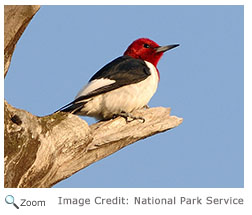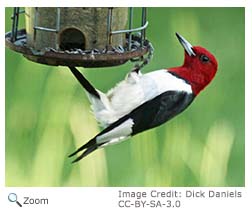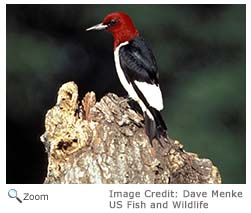Characteristics
 The red-headed woodpecker is a small woodpecker about 7-9 inches in length with a wingspan of 14-17 inches. It has a red head, neck and upper breast. It has a white lower chest and stomach, black wings with a white patch on the back and a black tail. It has a long, strong, sharp bill and black eyes. Males and females look alike. The red-headed woodpecker is a small woodpecker about 7-9 inches in length with a wingspan of 14-17 inches. It has a red head, neck and upper breast. It has a white lower chest and stomach, black wings with a white patch on the back and a black tail. It has a long, strong, sharp bill and black eyes. Males and females look alike.
Range
 The red-headed woodpecker can be found throughout the United States east of the Rocky Mountains. Northern populations may migrate in the winter. The red-headed woodpecker can be found throughout the United States east of the Rocky Mountains. Northern populations may migrate in the winter.
Habitat
The red-headed woodpecker can be found
open woodlands and forest edges and clearings, river bottoms, orchards, parks, open woods and wooded swamps and grasslands with trees. It especially likes areas with dead or dying trees.
|
|
Diet
 The red-headed woodpecker is omnivorous. It eats insects, spiders, earthworms, nuts, seeds, berries, fruit and occasionally small mammals. It may also eat bird eggs, fledglings, and mice. The red-headed woodpecker doesn't drill into trees to excavate insects as often as other woodpeckers. Instead, it perches on a tree branch or fence post and waits for flying prey to go by, or it forages on the ground for food. The red-headed woodpecker is omnivorous. It eats insects, spiders, earthworms, nuts, seeds, berries, fruit and occasionally small mammals. It may also eat bird eggs, fledglings, and mice. The red-headed woodpecker doesn't drill into trees to excavate insects as often as other woodpeckers. Instead, it perches on a tree branch or fence post and waits for flying prey to go by, or it forages on the ground for food.
 The red-headed woodpecker is one of only four species of woodpecker that stores food. It hides food in crevices in trees, under the bark of trees, in fence posts, and even under shingles in roofs! The red-headed woodpecker may even wedge a live grasshopper or beetle into a crevice to eat later! The red-headed woodpecker is one of only four species of woodpecker that stores food. It hides food in crevices in trees, under the bark of trees, in fence posts, and even under shingles in roofs! The red-headed woodpecker may even wedge a live grasshopper or beetle into a crevice to eat later!
Life Cycle
 The red-headed woodpecker nests in holes in dead trees, telephone poles, fence posts and even under roofs. The female lays 3 to 10 eggs. Incubation lasts 12 to 14 days. Both the male and the female incubate the eggs. The male incubates the eggs at night. Both parents feed and care for the chicks. The chicks fledge when they are 24 to 31 days old and can catch their own food shortly after they fledge. The red-headed woodpecker nests in holes in dead trees, telephone poles, fence posts and even under roofs. The female lays 3 to 10 eggs. Incubation lasts 12 to 14 days. Both the male and the female incubate the eggs. The male incubates the eggs at night. Both parents feed and care for the chicks. The chicks fledge when they are 24 to 31 days old and can catch their own food shortly after they fledge.
Behavior
Red-headed woodpeckers are solitary birds, except during mating and when raising young.
|